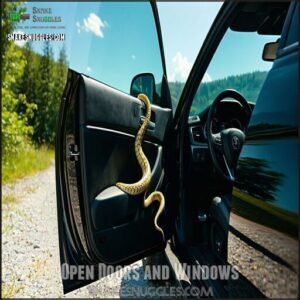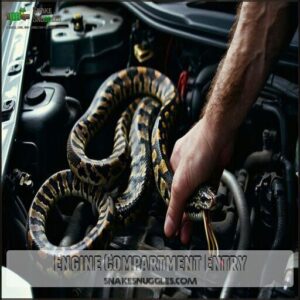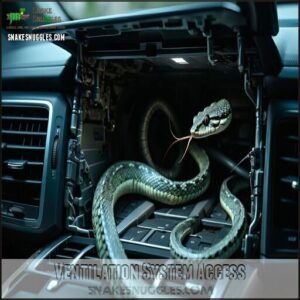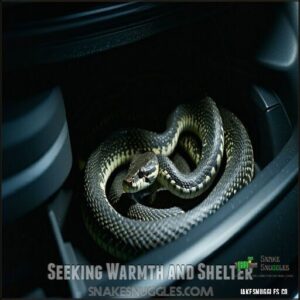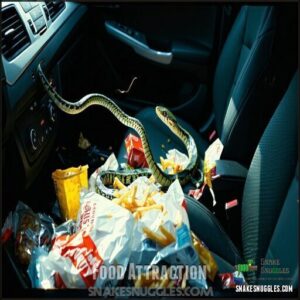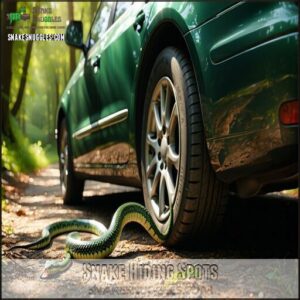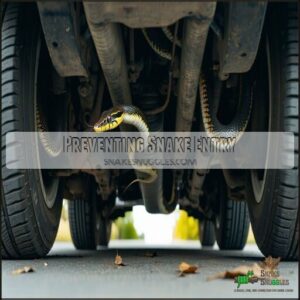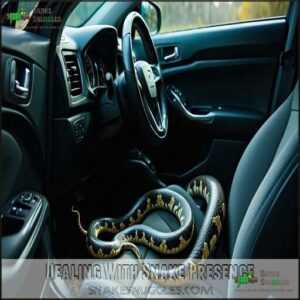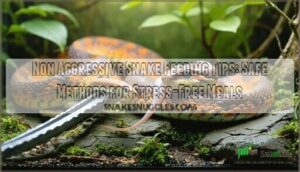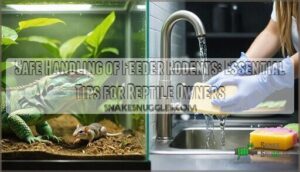This site is supported by our readers. We may earn a commission, at no cost to you, if you purchase through links.

You’ll want to park in a safe area, open all doors, and step away. Never try grabbing an unidentified snake—it could be venomous.
For immediate removal, call animal control or a professional snake handler who has the right tools and expertise. While waiting, keep children and pets away from the vehicle.
Prevention is simpler than dealing with a scaly surprise on your morning commute. The difference between a harmless hitchhiker and dangerous passenger comes down to knowing what you’re dealing with, and being aware of the potential for a scaly surprise can help you take immediate removal actions.
Table Of Contents
- Key Takeaways
- Snake Entry Points
- Why Snakes Enter Cars
- Snake Hiding Spots
- Preventing Snake Entry
- Dealing With Snake Presence
- Frequently Asked Questions (FAQs)
- What to do if a snake gets in your car?
- Is it possible for a snake to get inside a car?
- Can a snake live in a car engine?
- Can a snake survive getting hit by a car?
- What should I do if I spot a snake while driving?
- Will car insurance cover damage from a snake infestation?
- Is it safe to drive if I suspect a snake is still in my car?
- Can snakes reproduce and have babies inside car compartments?
- What insurance covers snake damage to cars?
- How do snakes affect car electrical systems?
- Conclusion
Key Takeaways
- If you find a snake in your car, don’t panic—park safely, open all doors, step away, and call animal control or a professional snake handler for safe removal.
- Snakes enter vehicles through undercarriages, open windows, engine compartments, or ventilation systems while seeking warmth, shelter, food, or escaping predators.
- You’ll prevent snake entry by parking in sealed garages, keeping windows and doors closed, sealing gaps in your car’s underbody, and eliminating rodents that attract snakes.
- Check for signs of snake presence like shed skin, unusual smells, or feces, and always prioritize safety by having professionals handle removal rather than attempting it yourself.
Snake Entry Points
Snakes can sneak into your car through surprisingly small openings like the undercarriage, open windows, or doors left ajar.
Tiny gaps become snake highways when your car offers warmth and shelter from the wild.
Understanding these entry points helps you spot potential risks and keep unwanted slithering visitors out, which is crucial for maintaining a safe environment.
Undercarriage Access
Ever wonder how a snake in your car got there?
The undercarriage is a prime culprit. Chassis entry points, like gaps near wheel wells, make it easy for snakes to slither in.
Ground clearance issues in older cars or rust impact can create openings.
Snakes love hiding among components near the car engine, avoiding road debris while seeking warmth and shelter.
Open Doors and Windows
Leaving open doors or windows can invite a snake in, especially in unattended vehicles.
Careless habits, like forgetting to shut them in a garage, increase the risk. Snakes see these openings as easy snake entry points into the car cabin.
Using remote starters or key fobs to lock up can help, ensuring your vehicle stays secure from unexpected slithering guests, which can be considered a secure measure.
Engine Compartment Entry
The engine bay is a prime spot for a snake in your car.
Warmth from the engine and easy undercarriage access make it irresistible.
Snakes use this area as shelter, but it can lead to component damage.
To prevent issues:
- Check under the hood often.
- Park away from tall grass.
- Seal gaps underneath.
- Avoid leaving the car idle long.
Ventilation System Access
After the engine bay, air vents can also attract a snake in your car.
Vent openings or gaps in the vent design might allow entry, especially for smaller species. Filter access points can be another weak spot.
Regular car inspection and system sealing help prevent surprises. Snakes love tight spaces, so don’t overlook these hidden areas during checks!
Ensuring proper airflow prevents condensation is critical for preventing snake entry, and it’s essential to maintain proper ventilation in your car.
Why Snakes Enter Cars
Snakes enter cars because they’re looking for warmth, shelter, or food. Your vehicle’s dark, enclosed spaces and engine heat make it an inviting spot, especially in cooler weather.
Seeking Warmth and Shelter
Snakes, being cold-blooded, are drawn to warmth and shelter, especially during cooler months.
Cars mimic burrows, offering cozy spots like garages or engine bays. They also provide safety from predators.
- Seasonal Shelter: Engines stay warm even after parking.
- Burrow Mimicry: Dark cabins feel safe.
- Predator Evasion: Cars shield snakes from threats outside.
Food Attraction
Snakes might slither into your car if food odors or a rodent infestation draws them in.
Rodents love garage clutter, pet food, or open containers, and snakes follow their prey. A rodent problem around your parking area can easily invite snakes.
Keeping your car and garage clean and rodent-free is key to avoiding these unwelcome passengers.
Predator Avoidance
Snakes may enter your car to escape predators, using vehicles as safe havens. Cars mimic burrows, providing dark, enclosed spaces for camouflage strategies. Plus, engine heat adds comfort.
To prevent this:
- Seal gaps to block escape routes.
- Inspect regularly for signs of snake safety issues.
- Use snake repellents around parking spots for added protection.
Geographic Factors
Why do snakes seem to love certain places?
Regional snake populations play a big role. States like Florida, Texas, and Tennessee, with warm climates and nearby snake habitats, see more encounters.
Rural areas near wooded spaces increase the risk, while urban spots aren’t immune.
Seasonal variations, like cooler months, also drive snakes to cars for warmth and shelter.
Snake Hiding Spots
Snakes are experts at finding cozy hiding spots in your car, from the engine bay to the cabin and trunk.
They’ll squeeze into wheel wells, undercarriages, and even air vents, making a thorough inspection essential.
Engine Bay Hiding
The engine bay is a prime hiding spot for a snake in your car.
It’s warm from engine heat, dark, and enclosed—everything a snake loves. Rodent attraction can also lure them in, as small prey often nest there.
Limited visibility makes spotting them tricky, and they might cause component damage. A professional inspection guarantees safety and peace of mind.
Cabin and Trunk Areas
How do snakes end up in your car’s cabin or trunk? They love confined spaces like under seats or the cozy Trunk Warmth near the engine.
To spot Hiding Snakes, follow these steps:
- Check the backseat for Backseat Vulnerability.
- Do an Interior Inspection, focusing on dark corners.
- Look for signs like shed skin.
- Call for snake removal if needed.
Wheel Wells and Undercarriage
After exploring the cabin and trunk, let’s talk about wheel wells and the undercarriage. These spots are like a snake’s VIP lounge—dark, cozy, and easy to access.
Rust vulnerability and undercarriage gaps make great entry points, while suspension hiding and tire proximity add to their appeal. Snakes may choose these locations to utilize disruptive patterns to remain unseen.
| Area | Why It Attracts Snakes | How to Check |
|---|---|---|
| Wheel Wells | Easy access, dark spaces | Inspect with a flashlight |
| Undercarriage Gaps | Warmth, hidden entry points | Look for gaps or damage |
| Suspension System | Tight, sheltered hiding spots | Check near tires carefully |
Dashboard and Air Vents
Occasionally, snakes find their way into your dashboard and air vents after gaining interior intrusion access.
While ventilation access is limited due to sealed plastic fittings, once a snake’s in your car, it’ll explore these dark spaces.
Your dashboard offers perfect hiding spots between components. If you suspect a snake hiding in these areas, look for subtle movement or listen for unusual sounds before attempting dashboard exploration.
Preventing Snake Entry
You can protect your vehicle from unwanted snake visitors with some simple preventive measures that block their access points.
You’ll sleep better knowing your car isn’t doubling as a snake hotel, especially during fall and winter when these reptiles actively seek warm shelters.
Parking Precautions
Smart parking choices can be your first line of defense against slithery visitors. Always opt for garage parking when possible, ensuring your garage is sealed properly.
Before exiting your vehicle, close all windows and doors completely. Avoid parking near tallgrass or wooded areas where snakes commonly reside.
Implement rodent control measures in your garage, as mice attract snakes. Regularly inspect your surroundings for signs of reptile activity.
Sealing Entry Points
Now that you’ve chosen a safe parking spot, it’s time to fortify your vehicle against unwanted reptilian visitors.
Check your car’s underbody for gaps where snakes might slither through. Install vent screening on larger openings and repair worn door seals.
For maximum protection, consider using a quality car vent screen.
Small window gaps can be snake highways, so verify they’re properly closed.
Patch holes in your firewall barriers for complete snake prevention. Remember, a well-sealed car is your best defense against scaly stowaways.
Removing Food Sources
After addressing structural vulnerabilities, don’t forget that snakes follow their stomachs. Eliminate rodents from your garage and car to remove the all-you-can-eat buffet that attracts snakes.
Keep your garage tidy, secure trash in sealed containers, and never leave pet food out overnight. Clean spills immediately and address any rodent problem with traps or professional help.
Without a food source, snakes will slither elsewhere for dinner. Maintaining a clean landscape helps with agricultural land snake control, which is crucial for effective snake control and removing the rodent problem.
Using Repellents
Snake-defense repellents can be your car’s best shield against unwanted serpent visitors. When applying these solutions, remember that effectiveness varies by type and application method.
- Natural repellents like cinnamon, cedarwood, and citronella essential oils mixed with water can deter snakes without harsh chemicals.
- Place repellent-soaked rags in plastic containers under your car, not inside the cabin.
- Consider using specialized vehicle deterrents for enhanced protection.
- For maximum protection, combine repellents with sealed entry points.
Dealing With Snake Presence
If you’ve discovered a snake in your car, you’ll need to act quickly but calmly to guarantee everyone’s safety.
You can identify snake presence through signs like shed skin or unusual movements, and it’s best to contact professional removal services rather than attempting to handle the situation yourself, which ensures safety.
Staying Calm and Safe
Now that your car is snake-proofed, let’s talk about what to do if you actually find one inside.
First, take a deep breath! Your immediate reaction matters for occupant safety. Assess the snake’s location from a safe distance and avoid provoking it with sudden movements.
Prioritize getting everyone out of the car safely, then contact experts like animal control. Recognizing aggressive behavior is essential for preventing bites.
Isolate the vehicle to prevent the snake from escaping while waiting for help.
Identifying Snake Signs
Now that you’re calm, you’ll need to confirm your scaly stowaway’s presence.
Here are 5 telltale signs a snake has made your vehicle its temporary home:
- Shed skin pieces in corners or under seats
- Snake feces (dark logs with white urea caps)
- Regurgitated food remains (partially digested prey)
- Unusual musky smells that weren’t there before
- Visual evidence like serpentine tracks in dust or dirt
These clues can help with snake identification before seeking removal help to ensure your safety and the safe removal of the snake.
Professional Removal Services
Now that you’ve spotted signs of a slithery stowaway, it’s time to call in the pros.
Wildlife removal specialists treat snake intrusions as emergencies and respond quickly.
Service costs typically range from $250-$600, depending on your location and the situation.
These reptile experts bring essential expertise needed for proper identification and safe handling.
Animal control professionals use specialized removal methods to capture and relocate your unwanted passenger without harming it or your vehicle.
Safe Removal Steps
Now that you’ve contacted professional help, follow these safe removal steps if you’ve got a snake in your car.
First, stay calm and assess the situation. Keep all windows and doors closed to isolate the vehicle. Maintain a safe distance while trying to identify the snake’s location without provoking it.
Turn off the engine, exit carefully, and prioritize occupant safety. A snake removal kit might be useful in some situations.
Give wildlife removal specialists a heads-up about the situation before they arrive, and remember to stay safe.
Frequently Asked Questions (FAQs)
What to do if a snake gets in your car?
If you see a snake in your car, stay calm and keep your distance.
Don’t provoke it.
Call animal control immediately.
Keep windows and doors closed to prevent escape while waiting for professional help.
Is it possible for a snake to get inside a car?
Yes, snakes can definitely get inside your car.
They’re attracted to the warmth, shelter, and darkness vehicles provide.
They’ll typically enter through open doors, windows, the undercarriage, or engine compartment when seeking refuge.
Can a snake live in a car engine?
Like a squatter in an apartment, a snake can temporarily live in your car engine.
They’re attracted to the warmth and shelter it provides, especially during cooler months when they’re seeking heat sources.
Can a snake survive getting hit by a car?
Many snakes can survive being hit by a car, depending on the impact’s severity and their location on the road.
You’ll often see injured snakes attempting to crawl away from traffic after being struck.
What should I do if I spot a snake while driving?
Keep your cool when you spot a snake while driving.
Pull over safely, stay calm, and don’t make sudden movements.
Call animal control for help rather than attempting to remove it yourself, as this is a task that requires professional handling.
Will car insurance cover damage from a snake infestation?
Most standard car insurance policies don’t cover snake damage unless you have full coverage. Check your policy details or call your agent to confirm what’s included in your specific plan.
Is it safe to drive if I suspect a snake is still in my car?
Imagine turning the key while something slithers beneath your feet.
It’s not safe to drive with a suspected snake in your car.
Pull over immediately and call animal control for professional removal.
Can snakes reproduce and have babies inside car compartments?
While snakes can technically breed anywhere, they rarely reproduce in cars.
The environment isn’t stable enough for nesting or egg-laying.
You’d likely notice a snake family before they’d settle in permanently.
What insurance covers snake damage to cars?
Like a safety net for unexpected reptile visitors, full or collision insurance typically covers snake damage to cars. You’ll need to check your policy details for specific coverage limitations.
How do snakes affect car electrical systems?
Your car’s electrical system can suffer when snakes chew through wires, causing short circuits, starting problems, or dashboard malfunctions.
They’re attracted to the warmth and shelter, potentially creating expensive repair needs.
Conclusion
Imagine your car as a cozy cave that sometimes attracts unwanted roommates.
When a snake got in your car, remember: prevention beats panic. Park smartly, seal entry points, and keep your vehicle clean.
If you do find a slithery passenger, stay calm, keep your distance, and call professionals.
With these simple precautions, you’ll reduce the chances of sharing your commute with a scaly stowaway. Your car should be your sanctuary, not a snake’s hideaway.


